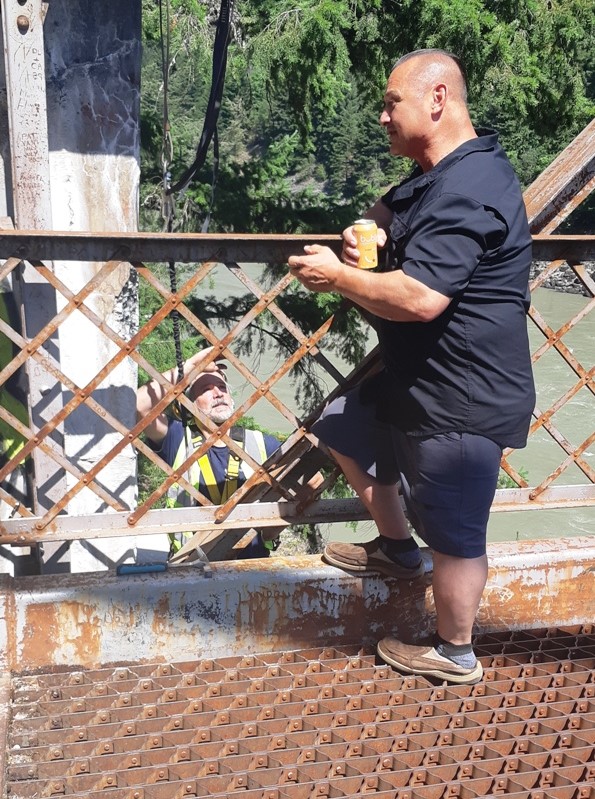(KEQUELOSE) Preliminary restoration work on the 1926 Alexandra Bridge situated in the heart of the Spuzzum First Nation started with a site visit on July 26. The goal of the visit was to assess the condition of the bridge structure’s two support towers and marked the start of field work for the 1926 Alexandra Bridge Rehabilitation Project’s (ABRP) 2021 season.
The ABRP is a partnership between the Spuzzum First Nation, New Pathways to Gold Society, Ministry of Transportation and Infrastructure (MOTI), BC Parks, BC Heritage Branch (Ministry of Forests, Lands and Natural Resource Development) and HeritageWorks.
“This initial phase of the project will determine how best to repair the concrete in the towers and other bridge elements such as railings,” says New Pathways to Gold Society (NPTGS) Co-Chair Terry Raymond.
“The longer-term goal is to restore this icon of B.C. transportation to a pedestrian bridge that will provide visitors with an unforgettable experience of the Fraser Canyon in the traditional territory of the Spuzzum First Nation (SFN).”
During the visit, members of the of Heritageworks, RJC Engineers and Heritage Masonry teams were on site, as well as SFN Chief James Hobart, SFN Assistant Housing Manager Crystal Hatzidimitriou and Richard Linzey, Director of Heritage Branch at Forests Lands and Natural Resource Operations.
“We’re very proud to be part of this project and to help find solutions to the challenges of preserving this beautiful structure,” says Gord Macdonald of Heritageworks.
“This phase of the project is an important first step in conserving the bridge and in understanding the decay mechanisms that will inform proposals for future works.”
The 1926 Alexandra Bridge was built on the foundations of the original Cariboo Waggon Road bridge (constructed in 1863) near the ancient village of Kequelose, a traditional crossing point on the Fraser River that’s connected the Coast with the Interior for millennia. It was decommissioned in 1964 after the construction of the new Alexandra Bridge, two km downstream. The old bridge is now the centerpiece of Alexandra Bridge Provincial Park, created in 1984.
The restoration work is being funded by the Community Economic Resiliency Infrastructure Program, which provided $500,000, and the Ministry of Transportation and Infrastructure (MOTI), which is contributing an additional $400,000.
SFN Chief and NPTGS Director James Hobart says the rehabilitation of the 1926 Alexandra Bridge is the key to unlocking the economic potential of the Lower Canyon for his people.
“We’re developing a campsite, a convention centre, new housing and other amenities that we hope will make the Spuzzum First Nation the Canyon’s largest employer,” says Hobart.
“I know there’s a lot of jokes about Spuzzum and how small we are, but in a few years, you won’t recognize it. It’s going to be a vibrant, happening place and the restored 1926 Alexandra Bridge is going to be at the heart of all of it.”
The BC Heritage Branch is working closely with MOTI engineering staff to obtain the best value out of the current round of investigation and repair. The bridge is a provincially designated heritage site.
“The 1926 Alexandra Bridge is important not only because it’s a beautiful structure situated in a dramatic landscape, it also stands atop 10,000 years of history,” said Richard Lindsay, BC Heritage Branch.
“Restoring the bridge and providing safe access to it will allow visitors a unique view of the Fraser River in the Canyon and help them connect to both the landscape and all the peoples who have moved through it during our shared history.”
The bridge restoration is also important to creating opportunities for Indigenous and non-Indigenous communities not just in the Fraser Canyon, but throughout the Hope-Barkerville “Gold Rush/Spirit Trails” corridor.
“We want the 1926 Alexandra Bridge at Kequelose to be what it always has been for millennia – a gateway between the Coast and the Interior that will attract visitors and encourage them to keep going and explore the rest of the Gold Rush/Spirit Trails,” says NPTGS Indigenous Co-Chair Cheryl Chapman.
“There are hundreds of incredible Indigenous, non-Indigenous and Multicultural experiences to be had in what is the most culturally and geographically diverse corridor in all of B.C.”
You can find updates on the NPTGS website at newpathwaystogold.ca. The project partners gratefully acknowledge the support of the Province of British Columbia though the Ministry of Forests, Lands and Natural Resource Development and the Ministry of Transportation and Infrastructure.


